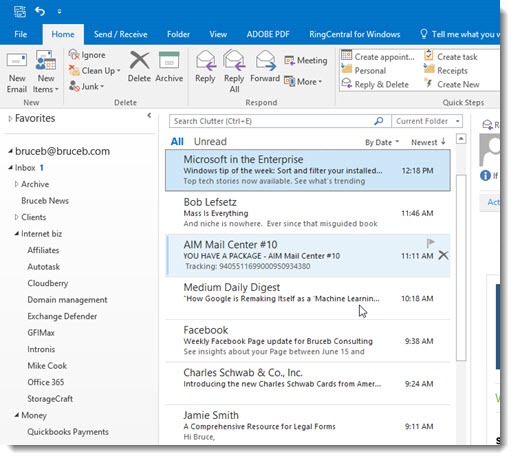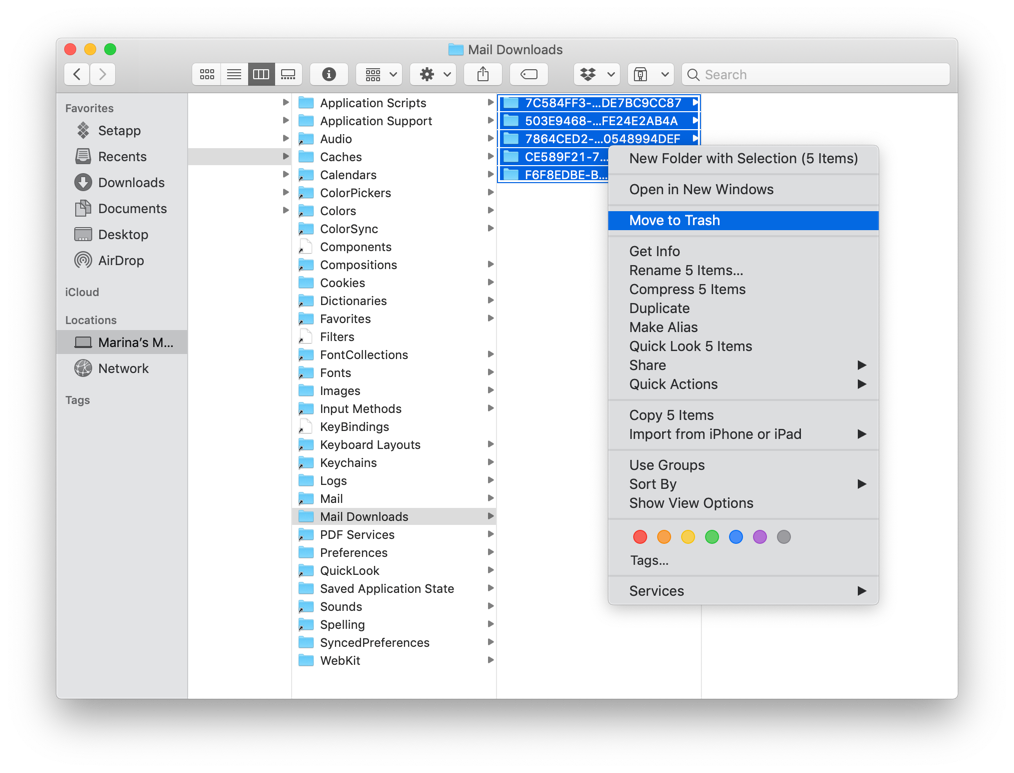- Delete Outlook Message Attachments Mac Library Folder Free
- Delete Outlook Message Attachments Mac Library Folder Windows 10
Create a top-level folder
Select a folder at the same level where you want to create the new folder.
From the Home tab on the Ribbon, click the New Items button, and then choose Folder at This Level.
The new folder will appear as Untitled Folder, with the name editable. Re-title it by typing the new title in the text box.
Create a nested folder

Select a folder in which you want to create a new folder.
From the Home tab on the Ribbon, click the New Items button, and then choose Folder.
The new folder will appear nested in the folder you selected in step 1 as Untitled Folder, with the name editable. Re-title it by typing the new title in the text box.
Delete a folder
Select the folder you want to delete by clicking on it to highlight it.
From the Home tab on the Ribbon, click Delete.
Dec 29, 2017 Launch Outlook again and look through the Inbox, Sent Items and Junk E-Mail folders. Highlight and delete anything you don't need. Go to the Deleted Items folder. Mark all items and delete them so the folder is empty. Rename the file You can rename the file (or request that the sender rename the file) to use an extension that Outlook doesn't block. For example, you can rename file.exe to file.docx. Once the renamed file is sent (or received), save it and rename it with the original extension using the following steps. Locate the attachment in the email message. Find instructions for creating and deleting a folder in Outlook 2016 for Mac. Add or remove a folder in Outlook for Mac. Delete a folder. Select the folder you want to delete by clicking on it to highlight it. From the Home tab on the Ribbon, click Delete.
Create a folder
In the navigation pane, click Mail , Contacts , Tasks , or Notes .
To create a sub-folder, select the folder under which the new one will be created.
Select Organize > New Folder.
Type a name for the new folder.
The above procedure explains how to create a subfolder of an existing folder. To create a folder on the same level in the hierarchy, select a folder, and then press SHIFT + OPTION + + N .
Delete a folder
Double-click the folder you want to delete.
Select Edit > Delete .
See Also
Delete Outlook Message Attachments Mac Library Folder Free
| Click here to return to the 'Save disk space by deleting copies of Mail attachments ' hint |
Note that the name of this folder is localized. In German it's called 'Geladene Mail-Anhänge' (Downloaded Mail Attachments)
@kirkmc - Mail saves the attachments for offline viewing.
I was going to say the same -- for IMAP connections, Mail keeps these offline so they're available without needing to re-download them each time...
Just another reason to stick with good-ol' POP...
Cheers,
Peter
Right--it actually makes a fair amount of sense on IMAP connections so you don't end up re-downloading large attachments repeatedly, since I'm pretty sure IMAP attachments are NOT downloaded along with the messages during a sync.
Example: I have a message with 10MB of large images attached to it in an IMAP account. With the 'delete on quit' option selected, every time I view that message, if I have quit Mail since the last time, it will need to re-download those 10MB of images to display them. For someone like me, who passes a lot of images around via email (business reasons), that would be incredibly annoying--it would render Mail.app nearly unusable, in fact.
Not really. Your comment made me test it - I disconnected from my internet connections and test-opened a bunch of attachments. They all opened no problem, without complaining that there was no connection to the IMAP server. I quit Mail, saw them deleted from the above mentioned folder, and repeated.
Attachments are stored offline in Mail, and this folder is a duplicate location when the user decides to open the attachment...
Just my 2 cents..
Interesting. I stand entirely corrected, then.
I had always assumed, since when you first view an IMAP message with large image attachments you can see the image attachments queueing for download, that they were going into that folder.
This being the case, this is a very valuable tip for those short on disk space (those of us with SSDs, in particular).

Actually you were partially right. The thing is that most email clients have an OPTION that allows you to keep copies of messages with or without attachments for offline viewing.
For your desktop or laptop computer turning this option on makes a LOT of sense, and I believe it is the default for Apple Mail and Outlook.
For other mobile devices like smartphones and tablets this option does NOT make a lot of sense so many mail clients don't even include it.
After noticing that this folder was taking up a lot of space on my mac, I cleared it out, and then set up a Hazel action for it, so that files added to it will only be in there for a few months, then trashed.
Delete Outlook Message Attachments Mac Library Folder Windows 10

Under Mountain Lion my version of this folder is ~/Library/Containers/com.apple.mail/Data/Library/Mail Downloads
@petersconsult not sure why you'd want to run POP in this day and age. I check the same e-mail accounts on 4 different devices, IMAP's the only way to stay sane doing that. http://en.wikipedia.org/wiki/Internet_Message_Access_Protocol#Advantages_over_POP
Seriously.
I'm as big a fan of local storage as the next luddite, but when you try to access three different mail accounts from a home desktop, a home laptop, a work desktop, an iPhone, and an iPod Touch in any functional way, POP does not cut it. Besides, with offline caching, there's really not that much difference between IMAP and POP (unless the IMAP server instructs your local computer to purge the entire contents of a folder or something, in which case you're relying on your local backup).
Thanks for the heads up. I found my downloads folder in the same place. Running Mountain Lion 10.8.3.
find ~/Library/Mail -name 'Attachments' -depth -exec rm -rf {} ;to clear disk space basically I create rules, It helps me to manage my account more efficiently.
Hello,
I had the same issue about having large amount of attachments in Mail, so I've done a little script to save attachments file into an external drive or directory, and also delete all attachments files gracefully
If IMAP, nor just 'find', is not enough for your case, maybe the script could be useful:
https://github.com/blues-man/mail-attachments-util
chmod 755 mail_util.sh
# Recover all attachments, organized by accounts and Folders, putting them on an external drive set explicitly in the script
./mail_util.sh
# Delete all attachments asking for each account
./mail_util.sh --delete
# Delete all attachments asking for each file per account
./mail_util.sh --delete --ask
Bye